SLC9A3R1
-
Official Full Name
solute carrier family 9, subfamily A (NHE3, cation proton antiporter 3), member 3 regulator 1 -
Overview
This gene encodes a sodium/hydrogen exchanger regulatory cofactor. The protein interacts with and regulates various proteins including the cystic fibrosis transmembrane conductance regulator and G-protein coupled receptors such as the beta2-adrenergic receptor and the parathyroid hormone 1 receptor. The protein also interacts with proteins that function as linkers between integral membrane and cytoskeletal proteins. The protein localizes to actin-rich structures including membrane ruffles, microvilli, and filopodia. Mutations in this gene result in hypophosphatemic nephrolithiasis/osteoporosis type 2, and loss of heterozygosity of this gene is implicated in breast cancer.[provided by RefSeq, Sep 2009] -
Synonyms
SLC9A3R1;solute carrier family 9, subfamily A (NHE3, cation proton antiporter 3), member 3 regulator 1;EBP50;NHERF;NHERF1;NHERF-1;NPHLOP2;Na(+)/H(+) exchange regulatory cofactor NHE-RF1;Na+/H+ exchange regulatory co-factor;regulatory cofactor of Na(+)/H(+) exchanger;ezrin-radixin-moesin binding phosphoprotein-50;ezrin-radixin-moesin-binding phosphoprotein 50;solute carrier family 9 isoform A3 regulatory factor 1;solute carrier family 9 (sodium/hydrogen exchanger), isoform 3 regulatory factor 1
Recombinant Proteins
- Human
- Zebrafish
- Mouse
- Chicken
- Rhesus macaque
- Rat
- Cynomolgus
- HEK293
- Mammalian Cells
- Wheat Germ
- E.coli
- In Vitro Cell Free System
- DDK
- Myc
- His
- Non
- Avi
- Fc
Background
What is SLC9A3R1 protein?
SLC9A3R1 also known as NHERF1 (NHERF family PDZ scaffold protein 1), is a protein coding gene which situated on the long arm of chromosome 17 at locus 17q25. This gene encodes a sodium/hydrogen exchanger regulatory cofactor. The protein interacts with and regulates various proteins including the cystic fibrosis transmembrane conductance regulator and G-protein coupled receptors such as the beta2-adrenergic receptor and the parathyroid hormone 1 receptor. The protein also interacts with proteins that function as linkers between integral membrane and cytoskeletal proteins. The protein localizes to actin-rich structures including membrane ruffles, microvilli, and filopodia. The SLC9A3R1 protein is consisted of 358 amino acids and SLC9A3R1 molecular weight is approximately 38.9 kDa.
What is the function of SLC9A3R1 protein?
SLC9A3R1 protein is a multifunctional scaffold protein that is involved in regulating a variety of cellular activities. SLC9A3R1 plays an important role in regulating the proliferation and metastasis of breast cancer cells. The study showed that SLC9A3R1 was able to stimulate the autophagy process by stabilizing BECN1 protein, a major component of the lipid kinase complex at the core of autophagy. SLC9A3R1 activates autophagy by reducing the interaction between BECN1 and BCL2, and is able to stimulate autophagy in part through the PTEN-PI3K-AKT1 signaling pathway. In addition, SLC9A3R1 binds to BECN1, thereby preventing the ubiquitin dependent degradation of BECN1.
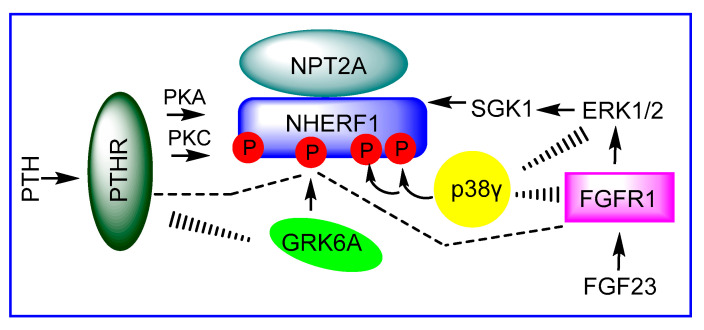
Fig1. NHERF1 brings together different classes of protein for NPT2A-dependent hormone-regulated phosphate transport in kidney cells. (Tatyana Mamonova, 2021)
SLC9A3R1 related signaling pathway
Slc9a3r1-related signaling pathway is mainly related to the regulation of the activity of sodium hydrogen exchange regulatory factor 3 (NHE3). SLC9A3R1 is a helper subunit of NHE3, which influences its transport activity and intracellular signaling by interacting with NHE3. NHE3 is responsible for the maintenance of acid-base balance in a variety of cell types, and is particularly important in the proximal convoluted tubule cells of the kidney. The expression level of SLC9A3R1 can affect the stability and activity of NHE3 on the plasma membrane, which in turn affects sodium reabsorption and acid-base balance in the kidney. Therefore, the study of SLC9A3R1-related signaling pathway is of great significance for understanding the molecular mechanism of kidney function, hypertension and related diseases.
SLC9A3R1 related diseases
The SLC9A3R1 gene plays an important role in human health and disease. It is mainly associated with high blood pressure, diabetes, obesity, metabolic syndrome and other diseases. These disorders often involve the body's regulation of sodium and blood pressure control. The protein encoded by the SLC9A3R1 gene is involved in regulating the activity of the sodium-hydrogen exchanger, a key mechanism for maintaining sodium and acid-base balance in the body. Therefore, variations in this gene may affect blood pressure and electrolyte balance, thereby increasing the risk of these diseases. Understanding the role of the SLC9A3R1 gene in these diseases could help develop targeted treatment strategies.
Bioapplications of SLC9A3R1
The biomedical applications of rhSLC9A3R1 are focused on the study and regulation of physiological and pathological processes associated with SLC9A3R1. By providing the recombinant protein, the researchers can more deeply explore the role of SLC9A3R1 in sodium-hydrogen exchange, ion balance, and acid-base homeostasis. In addition, rhSLC9A3R1 can be used to screen and develop potential treatments for high blood pressure, diabetes, obesity and other metabolic diseases. The use of recombinant proteins helps to verify the effectiveness of drug targets in vitro and in animal models, providing early molecular basis and pharmacological data for clinical treatment.
Case Study
Case Study 1: Hong Liu, 2015
Autophagy plays a role in curbing breast cancer growth and spread. The protein SLC9A3R1, which regulates autophagy in breast cancer cells, has an unknown mechanism of action. This study shows that in breast cancer cells with higher SLC9A3R1, the protein BECN1 that promotes autophagy is more stable due to reduced interaction with BCL2. SLC9A3R1 also protects BECN1 from degradation and activates autophagy, partially through the PTEN-PI3K-AKT1 pathway. SLC9A3R1 binds BECN1 to prevent its breakdown, and this binding is crucial for autophagy induction, as a truncated version of SLC9A3R1 that can't bind BECN1 fails to stimulate autophagy.
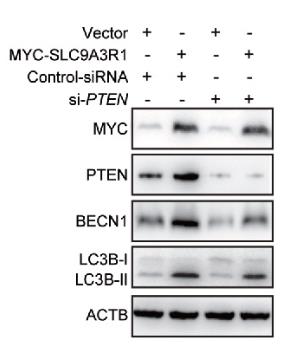
Fig1. PTEN is unnecessary for the activation of autophagy when SLC9A3R1 stimulates.
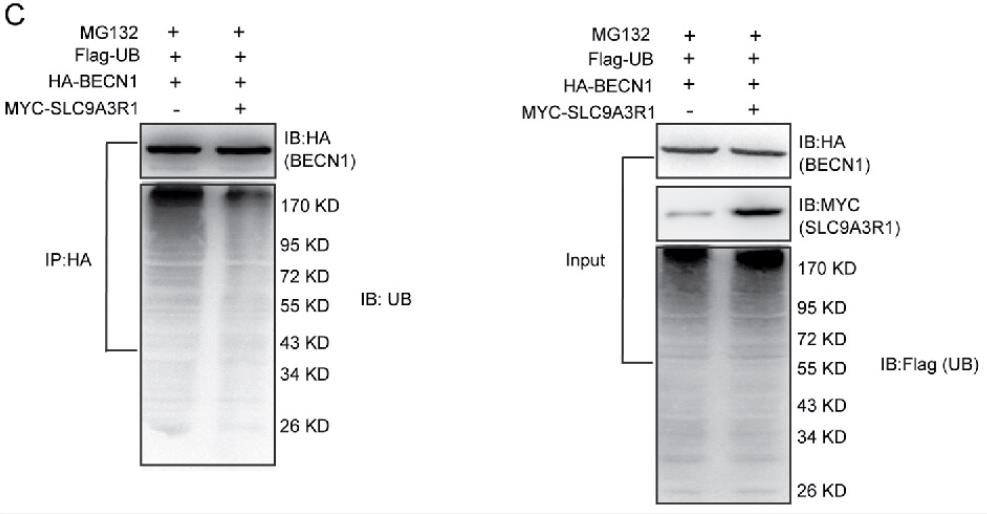
Fig2. Overexpression of SLC9A3R1 eliminates the ubiquitination of BECN1.
Case Study 2: Yong-Seok Oh, 2017
NHERF1, a protein that normally stabilizes protein complexes in polarized epithelial cells, is found in the cytoplasm of cancer cells, where its role is not well understood. This study showed that in ovarian cancer cells, NHERF1 moves to the plasma membrane and cortical protrusions upon LPA stimulation, a process that involves binding to phosphorylated ERM proteins (cpERMs). NHERF1 depletion reduced cpERM levels and affected cell cortex remodeling. Additionally, NHERF1 is involved in LPA-induced pseudopodia formation and chemotactic cell migration in cancer cells.
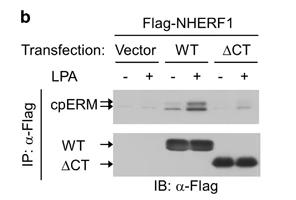
Fig3. LPA-induced interaction between NHERF1 and cpERM proteins.
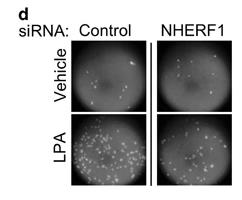
Fig4. Effect of NHERF1 depletion on LPA-induced migration of OVCAR-3 cells.
Quality Guarantee
High Purity
.jpg)
Fig1. SDS-PAGE (SLC9A3R1-13HFL)
Involved Pathway
SLC9A3R1 involved in several pathways and played different roles in them. We selected most pathways SLC9A3R1 participated on our site, such as PDGFR-beta signaling pathway,Thromboxane A2 receptor signaling, which may be useful for your reference. Also, other proteins which involved in the same pathway with SLC9A3R1 were listed below. Creative BioMart supplied nearly all the proteins listed, you can search them on our site.
| Pathway Name | Pathway Related Protein |
|---|---|
| PDGFR-beta signaling pathway | SNX15,DOK1,SLA,GRB10 |
| Thromboxane A2 receptor signaling | ARR3,ADRBK2 |
Protein Function
SLC9A3R1 has several biochemical functions, for example, PDZ domain binding,beta-2 adrenergic receptor binding,beta-catenin binding. Some of the functions are cooperated with other proteins, some of the functions could acted by SLC9A3R1 itself. We selected most functions SLC9A3R1 had, and list some proteins which have the same functions with SLC9A3R1. You can find most of the proteins on our site.
| Function | Related Protein |
|---|---|
| PDZ domain binding | DLG3,SLC9A3R2,ATP2B1B,PARK2,DOCK4,ERC1,ATP2B1,ATP2B1A,PDZK1,PSEN1 |
| beta-2 adrenergic receptor binding | NEDD4,GNAS,BDKRB2,PDE4D |
| protein self-association | SLC2A1,CTSC,ACVR2A,SYP,AXIN1,L1CAM,ABCD3,DVL2,ZNF496,TNFAIP3 |
| beta-catenin binding | GRIP1,CXADR,CDH2,GSK3B,CALCOCO1,TBL1XR1,BTRC,TCF7L1A,CD2AP,PTPRU |
| receptor binding | GSTK1,AKAP9,WNT2BB,Icosl,SNX17,EHHADH,SMARCD3,GNPAT,CSK,CNPY3 |
| protein binding | COMMD2,MSRB3,CYGB,TRIP4,CHD1,MOV10,PARN,TRAFD1,WDR20,CRHR2 |
| phosphatase binding | PPP1R26,CTSC,SPRED1,DYSFIP1,ELFN2,CARHSP1,TPRN,CHCHD3,CSRNP2,TRPC4AP |
| chloride channel regulator activity | SGK1,SGK2A,CHRNA7,SGK2B,SGK2,BSND,SGK3 |
| dopamine receptor binding | CLIC6 |
Interacting Protein
SLC9A3R1 has direct interactions with proteins and molecules. Those interactions were detected by several methods such as yeast two hybrid, co-IP, pull-down and so on. We selected proteins and molecules interacted with SLC9A3R1 here. Most of them are supplied by our site. Hope this information will be useful for your research of SLC9A3R1.
CFTR;PDGFRB;PTEN;MSN
Resources
Related Services
Related Products
References
- Dudakovic, A; Camilleri, ET; et al. Histone Deacetylase Inhibition Destabilizes the Multi-Potent State of Uncommitted Adipose-Derived Mesenchymal Stromal Cells. JOURNAL OF CELLULAR PHYSIOLOGY 230:52-62(2015).
- Dudakovic, A; Evans, JM; et al. Histone Deacetylase Inhibition Promotes Osteoblast Maturation by Altering the Histone H4 Epigenome and Reduces Akt Phosphorylation. JOURNAL OF BIOLOGICAL CHEMISTRY 288:28783-28791(2013).


